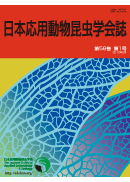Volume 56, Issue 1
Displaying 1-16 of 16 articles from this issue
- |<
- <
- 1
- >
- >|
Original Article
-
Article type: Original Article
2012Volume 56Issue 1 Pages 1-7
Published: February 25, 2012
Released on J-STAGE: March 01, 2012
Download PDF (865K)
Short communications
-
Article type: Short Communications
2012Volume 56Issue 1 Pages 9-12
Published: February 25, 2012
Released on J-STAGE: March 01, 2012
Download PDF (1049K) -
Article type: Short Communications
2012Volume 56Issue 1 Pages 12-15
Published: February 25, 2012
Released on J-STAGE: March 01, 2012
Download PDF (1075K) -
Article type: Short Communications
2012Volume 56Issue 1 Pages 16-18
Published: February 25, 2012
Released on J-STAGE: March 01, 2012
Download PDF (1061K) -
Article type: Short Communications
2012Volume 56Issue 1 Pages 19-22
Published: February 25, 2012
Released on J-STAGE: March 01, 2012
Download PDF (1098K) -
Article type: Short Communications
2012Volume 56Issue 1 Pages 22-25
Published: February 25, 2012
Released on J-STAGE: March 01, 2012
Download PDF (1167K)
Technical Note
-
Article type: Technical Note
2012Volume 56Issue 1 Pages 26-29
Published: February 25, 2012
Released on J-STAGE: March 01, 2012
Download PDF (902K)
-
Article type: Errata
2012Volume 56Issue 1 Pages 30
Published: January 25, 2012
Released on J-STAGE: March 01, 2012
Download PDF (391K) -
2012Volume 56Issue 1 Pages 31
Published: February 25, 2012
Released on J-STAGE: March 01, 2012
Download PDF (471K) -
2012Volume 56Issue 1 Pages 32-39
Published: February 25, 2012
Released on J-STAGE: March 01, 2012
Download PDF (1345K) -
2012Volume 56Issue 1 Pages 40
Published: February 25, 2012
Released on J-STAGE: March 01, 2012
Download PDF (407K) -
2012Volume 56Issue 1 Pages 41
Published: February 25, 2012
Released on J-STAGE: March 01, 2012
Download PDF (708K) -
2012Volume 56Issue 1 Pages H11
Published: February 25, 2012
Released on J-STAGE: March 01, 2012
Download PDF (214K) -
2012Volume 56Issue 1 Pages H12
Published: February 25, 2012
Released on J-STAGE: March 01, 2012
Download PDF (233K) -
2012Volume 56Issue 1 Pages H13
Published: February 25, 2012
Released on J-STAGE: March 01, 2012
Download PDF (143K) -
2012Volume 56Issue 1 Pages H14
Published: February 25, 2012
Released on J-STAGE: March 01, 2012
Download PDF (152K)
- |<
- <
- 1
- >
- >|
